Mad Hedge Technology Letter
November 11, 2020
Fiat Lux
Featured Trade:
(THE VULTURES AT ELLIOT MANAGEMENT)
(FFIV), (TWTR), (EBAY), (T)

Mad Hedge Technology Letter
November 11, 2020
Fiat Lux
Featured Trade:
(THE VULTURES AT ELLIOT MANAGEMENT)
(FFIV), (TWTR), (EBAY), (T)

Elliott Management’s dive into tech can be used as a leading indicator of which tech companies are great fixer-uppers.
Truth be told, Elliott Management, the vulture hedge fund, has a knack for finding those rusted cloud gems and polishing them shiny.
They don’t do this for free either, and making a killing on each of these turnaround stories usually has the same ruthless strategy.
Some of the prey were well-known within particular tech sector niches, like BMC, Novell and Informatica, but none were giants or household names.
Billionaire Paul Singer, notched sale after sale, reaping gains from the associated premiums on the acquisitions.
Most recently, his tech aspirations have increased with the pedigree of the company dwarfing in size he did before with stakes in eBay (EBAY), SAP, and AT&T (T).
This year, Elliott has already feasted on Twitter (TWTR) and SoftBank.
Part of the reason for slaying bigger dragons is because tech has gotten expensive with multiples expanding rapidly, and successfully leveraging usually works by going bigger and not smaller.
How does Elliott influence the change needed to raise the share prices?
First, getting his guys on the board to make decisions for the company.
He does this by getting his most trusted confidante and deal maker Jesse Cohn in the mix and he leads Elliott’s technology transactions.
He now sits on the boards of both eBay and Twitter.
Rather than scorching the earth for public change, he has worked in tandem with management at both companies.
Cohn is also supported by Elliott’s in-house Internet analysts, software analysts, operation analysts, consultants and stable of installed board members to help make decisions.
A decision they were at the forefront of was possibly firing Jack Dorsey at Twitter after identifying him as not maximizing profitability and revenue at Twitter.
Ultimately, Dorsey earned himself another quarter as CEO, but that’s how things work at Elliott, they run a tight ship.
Twitter said in a securities filing that a board committee formed this spring recommended that the current management structure remains in place for the time being.
The announcement gives Mr. Dorsey a reprieve after his performance was heavily criticized by Cohn and Elliott Management.
Twitter and Elliott reached an agreement in March in which the company agreed to appoint two board members and commit to $2 billion in share buybacks.
The agreement also included the formation of the new committee to study Twitter’s leadership, which effectively created a probation period for Mr. Dorsey to prove himself to the new investors.
So, does Elliott’s aggressive strategy work or fail?
The proof is in the pudding with Twitter shares up about 40% since bottoming out in March.
Twitter has expanded its userbase by about 23% since the fourth quarter of 2019.
So what now for Elliott?
Elliott is now one of the biggest investors in F5 Networks (FFIV), a Seattle company with a market value of about $8.8 billion.
They have spoken to the software company’s management about ways to appreciate the underlying shares which has not gone up in the past 365 days.
Shares have seriously underperformed to similar-sized cloud companies.
F5 Networks provides multi-cloud application services for the availability, security, performance, and availability of network applications, servers, and storage systems.
So far, they have announced plans to repurchase $1 billion worth of stock through fiscal 2022.
The buyback plan includes the accelerated repurchase of $500 million worth of stock in fiscal 2021.
The company said it targets double-digit adjusted earnings per share growth over the next two years and revenue growth of 6% to 7%, including software revenue growth CAGR of 35% to 40%.
These moves will help the company arrive at an inflection point in the transformation story where operating margins are poised to expand and revenue will accelerate, leading to sustainable double-digit growth
Elliott has also investigated some dubious decisions by F5’s management such as the company’s recent acquisitions of Shape Security Inc. and Nginx Software Inc., unhappy F5 overpaid without a clear integration strategy.
Elliott’ roadmap typically involves sizeable stakes in tech firms giving them the authority to throw their weight around behind the scenes.
Stock buybacks, acquiring company board seats, reducing expenses, acquisitions, wholesale management changes are part of their recipe for raising the stock price.
I have no reason to believe that Elliott will fail this time around after their string of tech successes and that leads me to recommend F5 Networks as a great buy the dip tech story.
The first stage of the turnaround is usually the most dramatic and noticeable with the follow-through to the flagging share price.
I wouldn’t be shocked if shares are up 25% from current prices in Q1 2021.
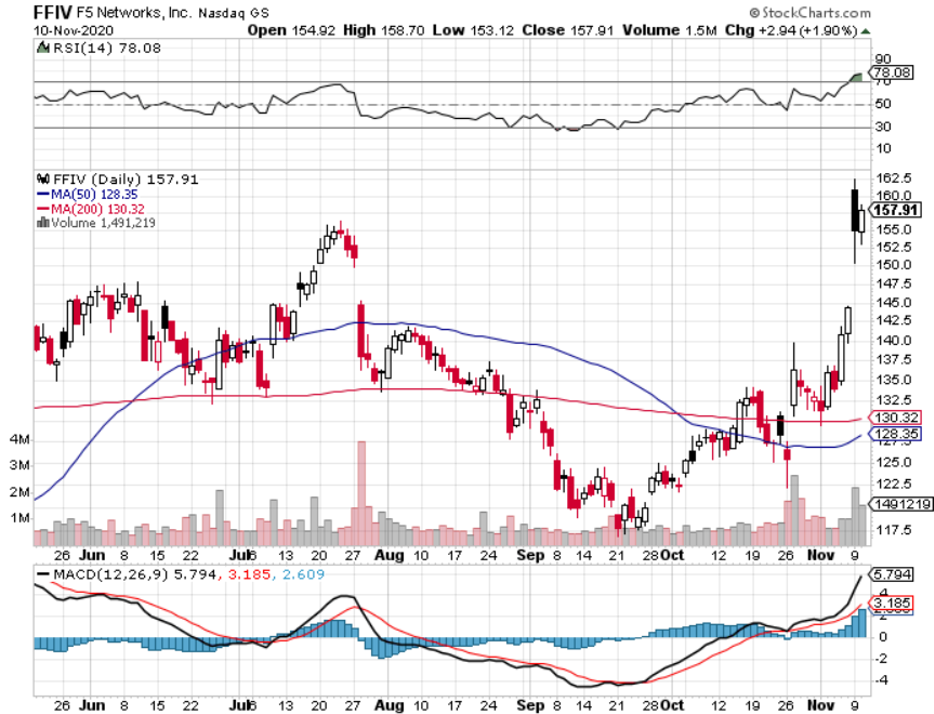
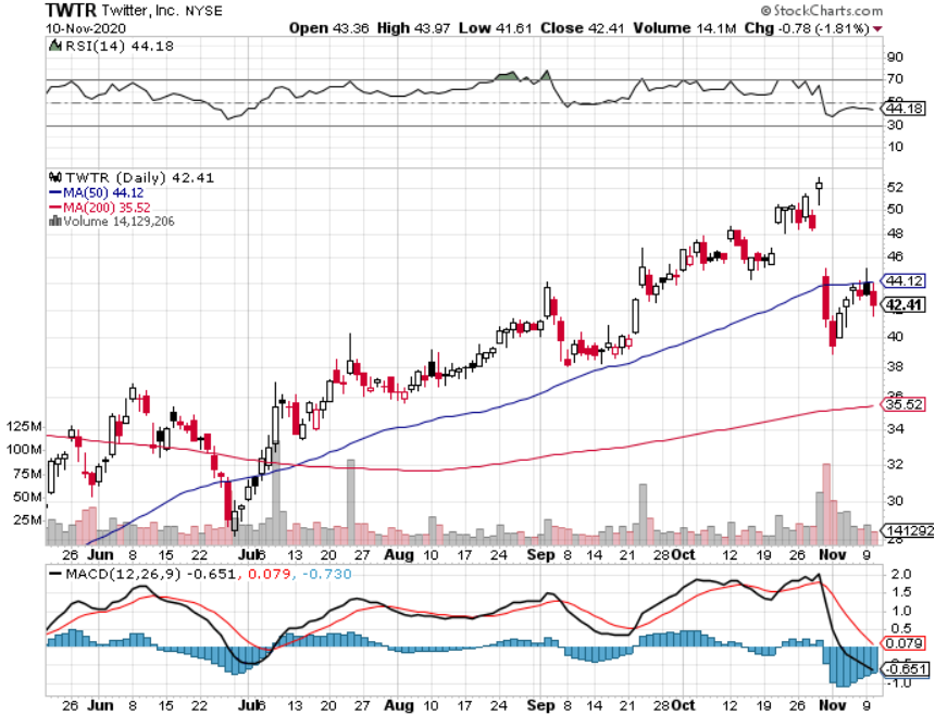
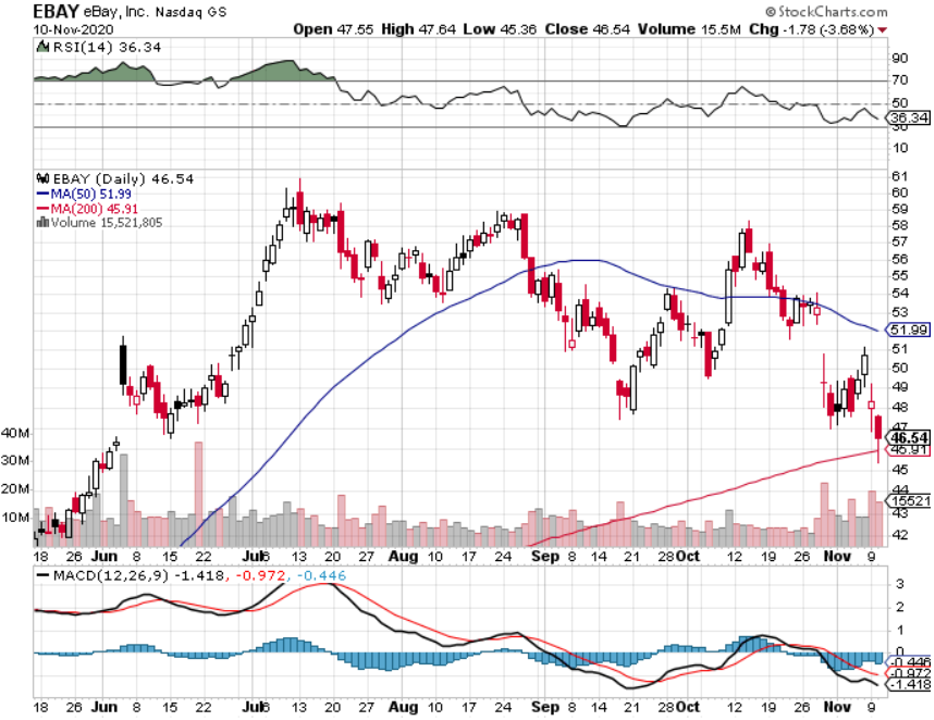
Mad Hedge Technology Letter
October 28, 2020
Fiat Lux
Featured Trade:
(THE CLOUD MOVEMENT IS INTACT)
(FFIV), (CRM), (CLOU)

We got another solid sign that the software-as-a-service (SaaS) phenomenon is sticky as ever. You can simply play this with cloud ETF — Global X Cloud Computing ETF Global X Cloud Computing ETF (CLOU)
One of the leading cloud barons of our time, Salesforce.com (CRM) Chief Executive Officer Marc Benioff criticized German rival SAPs business performance in explicit words, rejecting the idea that the German software giant’s challenges are a sign of things to come for his company.
Benioff said that at “SAP, you can see they’re having very significant troubles with the CEO transition they’re going through…they, as you know, moved from one CEO to two, they fired one of those two CEOs. The CEO transition is just not going well and their customers are saying that. Now you can see that their revenues are also reflecting this trouble.”
Protecting his industry makes sense as SAP have decided to blame the cloud industry on their woes and not their management.
Fair enough but Benioff is clearing the debris off the runway and offering a more accurate and rosier snapshot of the current cloud industry.
It’s certainly investor’s every right to worry over SAP’s decision to cut its full-year forecast that helped drag down other software makers, including Salesforce.
Benioff also chimed in and said, “SAP’s troubles, I think, are unique to them.”
Salesforce hasn’t felt the same weakness in guidance, and it was only just this past August, Salesforce reported quarterly sales increased 29% and jacked up its revenue forecast for the year.
The addressable market is growing, and Salesforce is making headway in that market.
Even weaker cloud companies are still showing a healthy heartbeat like Seattle-based F5 Networks (FFIV) saw shares rise after its fiscal fourth quarter earnings report beat expectations.
The company posted revenue of $615 million, up 4%, and non-GAAP earnings per share of $2.59. Wall Street expected revenue of $606 million and EPS of $2.37.
F5 Networks continues to benefit from its move into software and services, expanding beyond its traditional networking hardware business. Software revenue was up 36% from the year-ago quarter and their hardware business drags the overall growth number down to single digits.
The SaaS success is why President and CEO of F5 François Locoh-Donou has indicated that F5 is jumping headfirst into SaaS and nothing will stop this strategy apart from an apocalypse.
Locoh-Donou laid out the company’s strategy to enable “adaptive applications” that can adapt based on the environment.
F5 plans to leverage its traditional application delivery technologies along with its $1 billion acquisition of Shape Security and $670 million acquisition of web server NGINX to position itself as a key player amid a larger trend of automation and artificial intelligence driving advances in software applications and computer networks.
Cloud companies are held up so well that Locoh-Donou told employees that F5 won’t make layoffs during its fiscal year 2020.
I believe that this upcoming earnings season will offer more olive branches into why software stocks continue to be solid, but it's is not to say they aren’t expensive in the short-term.
The software-as-a-service (SaaS) business model continues to be a buckle-your-seatbelt-up growth leader, but other cloud-based services are poised to eclipse it as it matures.
SaaS applications are expected to deliver a highest-ever $105 billion in revenue this year, even as global technology spend dropped 8%, or about $300 billion.
The largest x-factor to SaaS was the broad-based pivot to cloud applications to accommodate remote working.
Even after workers return to the office, SaaS will continue growing because of the computing power and agility it could offer that otherwise couldn't afford it if they had to buy an on-premises or enterprise solution.
SaaS revenue is poised to surpass $121 billion next year and $141 billion in 2022.
For the five-year period between 2018 and 2022, SaaS will grow at a 12% annual rate.
We are now entering the consolidation phase for SaaS where companies are slowly replacing the last on-premises stalwarts in their portfolio, but the low-hanging fruit has mostly been harvested.
The applications with the strongest business case for SaaS have mostly been implemented.
SaaS companies are also facing increased competition and the numbers validate this as SaaS companies typically competed against three other companies in 2012, but by 2017, a SaaS startup could expect to face nine competitors in the same market segment.
Take for instance the digital market industry, the number of SaaS products increased from about 500 to 8,500 during that 5-year period.
The SaaS model has proven to be robust and critical to business continuity.
It will continue to be the preferred deployment mechanism for most applications and until this overarching strategy shifts, the money will be poured into SaaS software.
The first-mover advantage will take hold as the more marginal SaaS applications appear; the more customers will migrate into “brand” names.
For companies like Salesforce and F5 Networks, this means tailwinds, but it will virtually be impossible to become a new SaaS start-up in 2020 as this industry starts to mature.
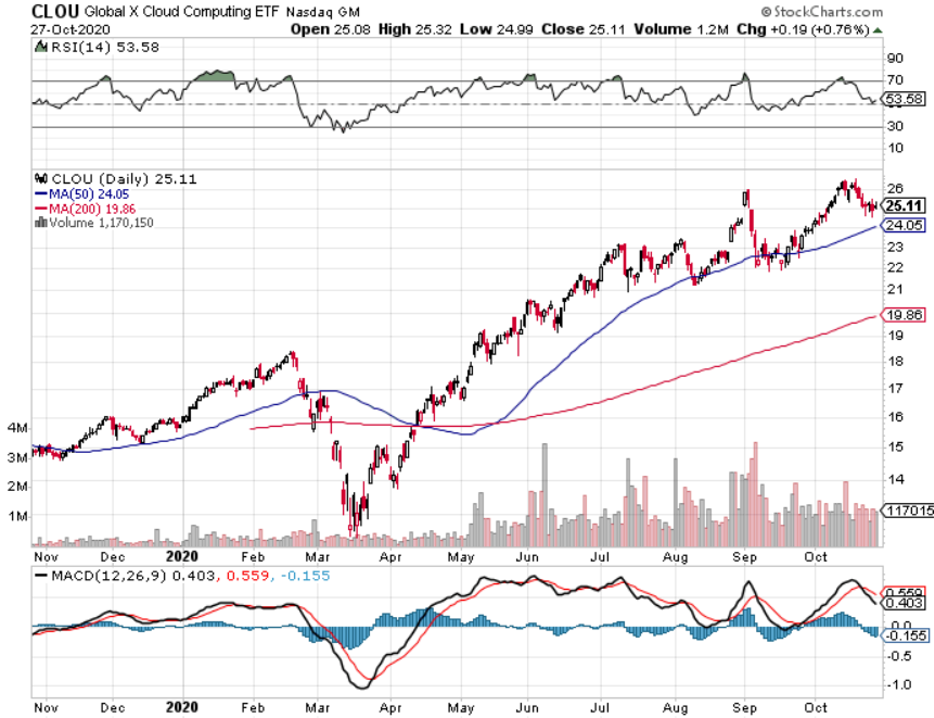
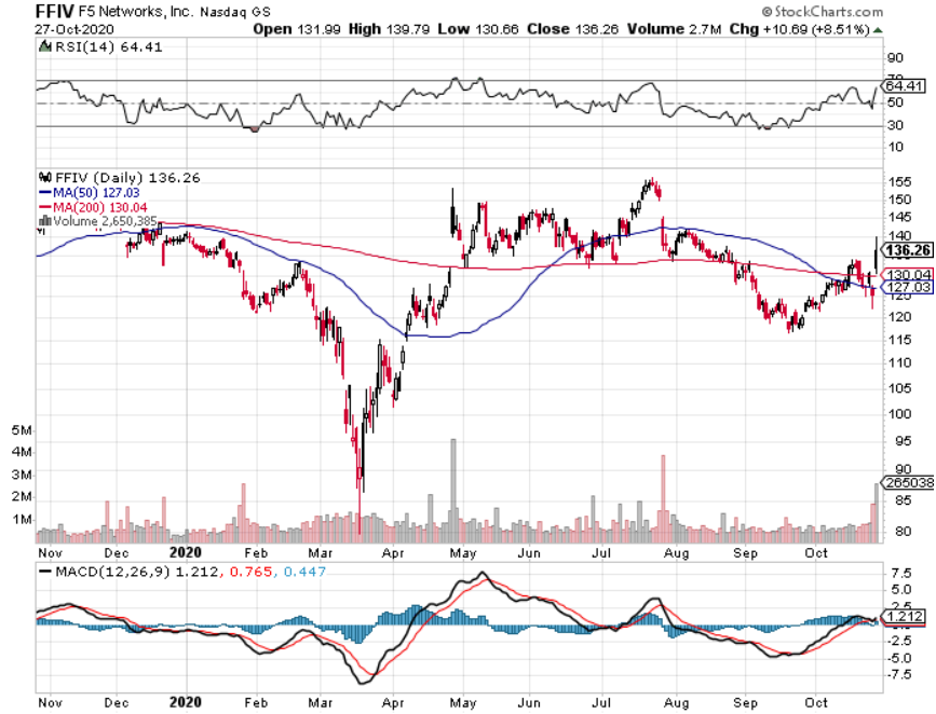
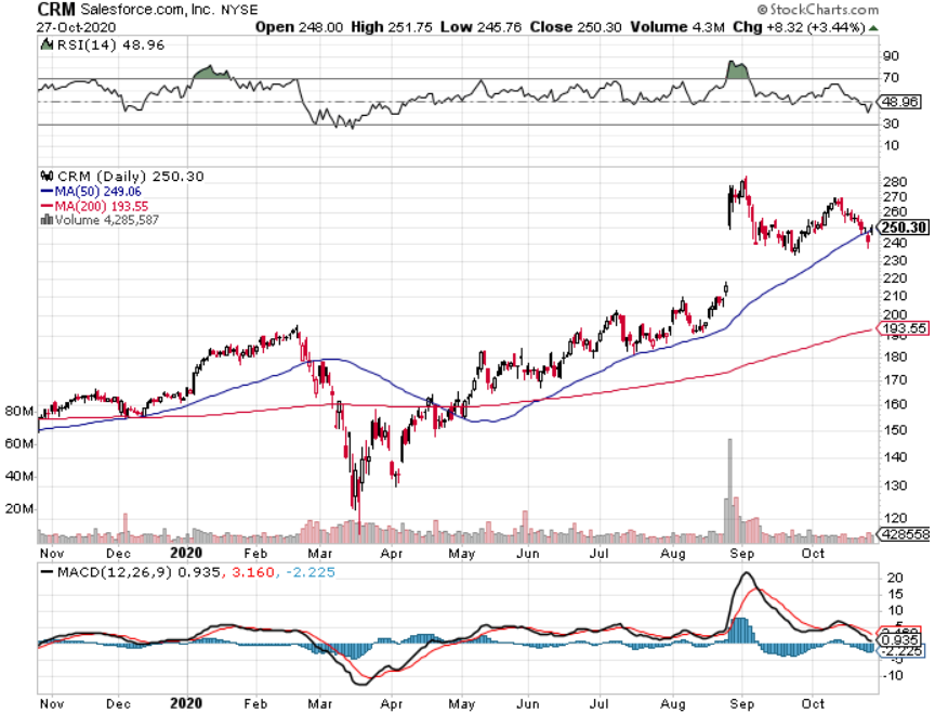
Legal Disclaimer
There is a very high degree of risk involved in trading. Past results are not indicative of future returns. MadHedgeFundTrader.com and all individuals affiliated with this site assume no responsibilities for your trading and investment results. The indicators, strategies, columns, articles and all other features are for educational purposes only and should not be construed as investment advice. Information for futures trading observations are obtained from sources believed to be reliable, but we do not warrant its completeness or accuracy, or warrant any results from the use of the information. Your use of the trading observations is entirely at your own risk and it is your sole responsibility to evaluate the accuracy, completeness and usefulness of the information. You must assess the risk of any trade with your broker and make your own independent decisions regarding any securities mentioned herein. Affiliates of MadHedgeFundTrader.com may have a position or effect transactions in the securities described herein (or options thereon) and/or otherwise employ trading strategies that may be consistent or inconsistent with the provided strategies.
This site uses cookies. By continuing to browse the site, you are agreeing to our use of cookies.
OKLearn moreWe may request cookies to be set on your device. We use cookies to let us know when you visit our websites, how you interact with us, to enrich your user experience, and to customize your relationship with our website.
Click on the different category headings to find out more. You can also change some of your preferences. Note that blocking some types of cookies may impact your experience on our websites and the services we are able to offer.
These cookies are strictly necessary to provide you with services available through our website and to use some of its features.
Because these cookies are strictly necessary to deliver the website, refuseing them will have impact how our site functions. You always can block or delete cookies by changing your browser settings and force blocking all cookies on this website. But this will always prompt you to accept/refuse cookies when revisiting our site.
We fully respect if you want to refuse cookies but to avoid asking you again and again kindly allow us to store a cookie for that. You are free to opt out any time or opt in for other cookies to get a better experience. If you refuse cookies we will remove all set cookies in our domain.
We provide you with a list of stored cookies on your computer in our domain so you can check what we stored. Due to security reasons we are not able to show or modify cookies from other domains. You can check these in your browser security settings.
These cookies collect information that is used either in aggregate form to help us understand how our website is being used or how effective our marketing campaigns are, or to help us customize our website and application for you in order to enhance your experience.
If you do not want that we track your visist to our site you can disable tracking in your browser here:
We also use different external services like Google Webfonts, Google Maps, and external Video providers. Since these providers may collect personal data like your IP address we allow you to block them here. Please be aware that this might heavily reduce the functionality and appearance of our site. Changes will take effect once you reload the page.
Google Webfont Settings:
Google Map Settings:
Vimeo and Youtube video embeds:
